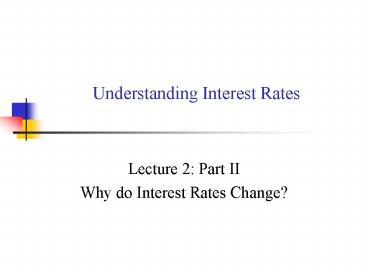Understanding Interest Rates
1 / 24
Title: Understanding Interest Rates
1
Understanding Interest Rates
- Lecture 2 Part II
- Why do Interest Rates Change?
2
Main Contents
- Supply and Demand in the Bond Market
- Market Equilibrium
- Changes in Equilibrium Rates
3
Determination of Asset Price
- Why do the prices of assets fluctuate? What
factors determine the price movements of an
asset? - An invisible hand
- Fix supply. When demand increases, price
increases when demand decreases, price
decreases. - Fix demand. When supply increases, price
decreases when supply decreases, price
increases.
Relationship between demand and supply
4
Determinants of Asset Demand
- What factors affect the demand of an asset?
- Wealth
- Wealth increases, more financial resource
available, more demands
5
Determinants of Asset Demand
- What factors affect the demand of an asset?
- Expected return rate of this asset relative to
alternative assets. - Return rate
- Initial investment value
- Final investment value
- Capital gain
- Direct incomes (e.g., interests,
dividends, rents, etc. )
6
Determinants of Asset Demand
- What factors affect the demand of an asset?
- Risk uncertainty associated with return
- For risk averse people, they prefer to hold
less risky assets.
7
Determinants of Asset Demand
- What factors affect the demand of an asset?
- Liquidity how quickly the asset can be converted
into cash without incurring large costs
8
Determinants of Bond Demand
- Summary
- Wealth
- Expected return
- Risk
- Liquidity
9
Determinates of Bond Supply
- What factors will affect the supply of a bond?
- Expected investment profitability
- The more profitable a firm expects in its
business, the more willing it will be to borrow
and then the more bonds it will be to issue.
10
Determinates of Bond Supply
- What factors will affect the supply of a bond?
- Expected inflation
- Higher inflation rates means lower real
interest rates. Thus, the cost of borrowing falls
as inflation rate increases. Firms are willing to
borrow more (issue more bonds) when the inflation
rate is high.
11
Determinates of Bond Supply
- What factors will affect the supply of a bond?
- Government activities
- Government usually issue bonds to finance its
expenditures. This can also affect the supply of
bonds.
12
Determinants of Bond Supply
- Summary
- Expected investment profitability
- Expected inflation
- Government activities
13
Demand and Supply Curves
- Supply and demand curve of the bond
Market Equilibrium 1. Occurs when Bd Bs, at P
850, i 17.6 2. When P 950, i 5.3, Bs
gt Bd (excess supply) P ? to P, i ?to i 3. When
P 750, i 33.0, Bd gt Bs (excess demand) P ?
to P, i ? to i
14
Market Equilibrium
- Market equilibrium occurs when the amounts of
demand and supply equal to each other. The price
at that time is called the equilibrium price or
market-clearing price. - The market has a tendency to head toward the
equilibrium price. - When excess supply, price drops down
- When excess demand, price climbs up.
15
Changes in Equilibrium Interest Rates
- If excess supply in the bond market, bond price
drops and the interest rate (YTM) increases. - If excess demand in the bond market, bond price
climbs and the interest rate decreases.
16
Changes in Equilibrium Interest Rate
- The effect of wealth
- As the wealth of individuals increases, they
have surplus money available to invest. So the
demand of bonds will be increasing.
17
Changes in Equilibrium Interest Rate
- The effect of risk
- An increase in the riskiness of bonds causes
the demand for bonds fall. - How about other factors? (I leave it as
homework)
18
Application I The Fisher Effect
- What will interest rates change when the economy
is in inflation? - Demand falls
- Supply increases
19
Application I The Fisher Effect
- The market equilibrium rate increases
20
Application II The Effects of a Business Cycle
on Interest Rates
- The macro-economy activities of a society
fluctuate over time. - Rapid growth sometimes
- Stagnation or decline sometimes.
- What is the effect of a business cycle on
interest rates? - In the periods of business expansion
- In the periods of business recession
21
Application II The Effects of a Business Cycle
on Interest Rates
- When the whole economy is under an expansion,
- Demand of bonds
- Wealth increases, bond demand increases
- Supply of bonds
- More profitable investment opportunities, bond
supply increases too. - Inflation increases, the Fisher effect.
22
Application II The Effects of a Business Cycle
on Interest Rates
- In the picture, the level of equilibrium interest
-
rate increases -
when the whole -
economy -
expands. But -
that is not -
necessarily true.
23
Application II The Effects of a Business Cycle
on Interest Rates
- When the whole economy is in a recession,
- Demand of bonds
- Wealth decreases and inflation pressure decreases
(even deflation, a negative inflation rate) - Supply of bonds
- No profitable investment opportunities.
- Inflation pressure decreases.
- The level of equilibrium interest rate decreases
24
Application II The Effects of a Business Cycle
on Interest Rates
- Business cycle and interest rates































